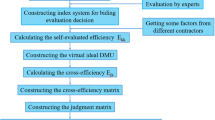Abstract
The existing framework for the procurement of products and services for the Greek Public Organizations describes specific criteria structure and fixed-weighted formulas for the assessment of the provider’s bids. This assessment procedure suffers from specific shortcomings: it overestimates the price, it is very sensitive to small changes to performance indicators and especially for the services, is not able to incorporate variable price information. In this paper we develop a Data Envelopment Analysis model that overcomes the above mentioned shortcomings. It uses variable weights that are estimated in favor of each evaluated bid and are properly restricted to comply with the existing framework and to reflect criteria priorities. It also encounters ranges for prices that correspond to minimum and maximum expected number of service calls. For illustration purposes we provide a real case application for the assessment of courier service providers.
Similar content being viewed by others
References
Adler N, Friedman L, Sinuany-Stern Z (2002) Review of ranking methods in the data envelopment analysis context. Eur J Oper Res 140(2):249–265
Allen R, Athanassopoulos A, Dyson RG, Thanassoulis E (1997) Weights restrictions and value judgments in data envelopment analysis: evolution, development and future directions. Ann Oper Res 73(0):13–34. doi:10.1023/A:1018968909638
Ammin G, Toloo M (2007) Finding the most efficient DMUs in DEA: an improved integrated model. Comput Ind Eng Arch 52(1):71–77
Anderson T, Hollingsworth K, Inman L (2002) The fixed weighting nature of a cross-evaluation model. J Prod Anal 17:249–255
Banker RD, Chang H (2006) The super-efficiency procedure for outlier identification, not for ranking efficient units. Eur J Oper Res 175(2):1311–1320
Banker RD, Thrall RM (1992) Estimation of returns to scale using data envelopment analysis. Eur J Oper Res 62(1):74–84
Banker RD, Charnes A, Cooper WW (1984) Some models for estimating technical and scale inefficiencies in data envelopment analysis. Manage Sci 30:1078–1092
Bao C-P, Chen T-H, Chang S-Y (2008) Slack-based ranking method: an interpretation to the cross-efficiency method in DEA. J Oper Res Soc 59:860–862
Boles JN (1967) Efficiency squared—efficient computation of efficiency indexes. In: Western farm economic association. Proceedings 1966, pp 137–142
Boles JN (1971) The 1130 Farrell efficiency system-multiple products, multiple factors. Giannini Foundation of Agricultural Economics, University of California, Berkeley, USA
Charnes A, Cooper WW, Rhodes E (1978) Measuring the efficiency of decision making units. Eur J Oper Res 2:429–444
Chen Y (2005) Measuring super-efficiency in DEA in the presence of infeasibility. Eur J Oper Res 161(2):545–551
Chen J-X, Deng M, Gingras S (2011) A modified super-efficiency measure based on simultaneous input–output projection in data envelopment analysis. Comput Oper Res 38(2):496–504
Coelli TJ, Perelman S (1999) A comparison of parametric and non parametric distance functions: with application to European railways. Eur J Oper Res 117:326–339
Cook WD, Liang L, Zha Y, Zhu J (2009) A modified super-efficiency DEA model for infeasibility. J Oper Res Soc 69:276–281
Copper WW, Park KS, Yu G (1999) IDEA and AR-IDEA: models for dealing with imprecise data in DEA. Manage Sci 45:597–607
Deprins D, Simar L, Tulkens H (1984) Measuring labor efficiency in post offices. In: M. Marchand, P. Pestieau, H. Tulkens (eds) The performance of public enterprises: concepts and measurement. North Holland, Amsterdam, pp 243–267
Despotis DK, Smirlis YG (2002) Data envelopment analysis with imprecise data. Eur J Oper Res 140:24–36
Doyle R, Green R (1995a) Cross-evaluation in DEA: improving discrimination among DMUs. INFOR 33:3
Doyle R, Green R (1995b) Mutliattribute choice for the lazy decision maker: let the alternatives decide!. Organ Behav Hum Decis Process 62(1):87–100
Farrell MJ (1957) The measurement of productive efficiency. J Roy Stat Soc 120:253–281
Forker LB, Mendez D (2001) An analytical method for benchmarking best peer suppliers. Int J Enterp Inf Manag 21(1–2):195–209
Garfamy RM (2006) A data envelopment analysis approach based on total cost of ownership for supplier selection. Int J Enterp Inf Manag 19(6):662–678
Ho W, Xu X, Prasanta D (2010) Mutli-criteria decision making approaches for supplier evaluation and selection: a literature review. Eur J Oper Res 202:16–24
Hoffman AJ (1957) Discussion on Mr. Farrell’s paper. J Royal Stat Soc Ser A 120(III):284
Lam KF (2010) In the determination of weight sets to compute cross-efficiency ratios in DEA. J Oper Res Soc 61:134–143
Lee H-S, Chu C-W, Zhu J (2011) Super-efficiency DEA in the presence of infeasibility. Eur J Oper Res (in press)
Li S, Jahanshahloo GR, Khodabakhshi M (2007) A super-efficiency model for ranking efficient units in data envelopment analysis. Appl Math Comput 184(2):638–648
Liang L, Wu J, Cook W, Zhu J (2008) The DEA game cross-efficiency model and its Nash equilibrium. Oper Res 56(5):1278–1288
Pastor JT, Ruiz JL, Sirvent I (1999) A statistical test for detecting influential observations in DEA. Eur J Oper Res 115:542–554
Seiford LM, Zhu J (1998) Sensitivity analysis of DEA models for simultaneous changes in all the data. J Oper Res Soc 49:1060–1071
Seiford LM, Zhu J (1999a) An investigation of returns to scale in data envelopment analysis. Omega 27:1–11
Seiford LM, Zhu J (1999b) Infeasibility of super-efficiency data envelopment analysis models. INFOR 37(2):174–187
Seiford LM, Zhu J (1999c) Sensitivity and stability of the classifications of returns to scale in data envelopment analysis. J Prod Anal 12:55–75
Simar L, Wilson PW (1998) Sensitivity analysis of efficiency scores: how to bootstrap in nonparametric frontier models. Manage Sci 44:49–61
Xue M, Harker PT (2002) Note: ranking DMUs with infeasible super-efficiency DEA models. Manag Sci 48(5):705–710
Author information
Authors and Affiliations
Corresponding author
Rights and permissions
About this article
Cite this article
Panta, M., Smirlis, Y. & Sfakianakis, M. Assessing bids of Greek public organizations service providers using data envelopment analysis. Oper Res Int J 13, 251–269 (2013). https://doi.org/10.1007/s12351-011-0108-4
Received:
Revised:
Accepted:
Published:
Issue Date:
DOI: https://doi.org/10.1007/s12351-011-0108-4
Keywords
- Data envelopment analysis
- Assessment of service providers
- Greek public organization procurement system



